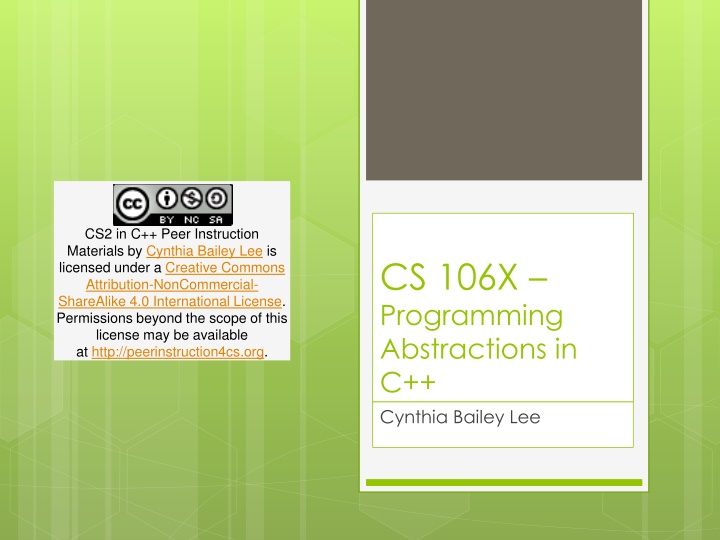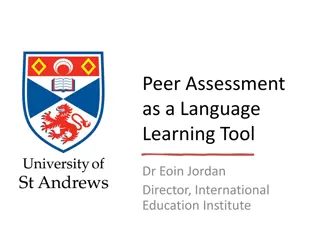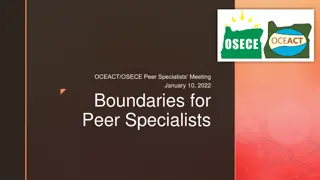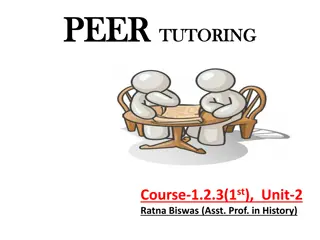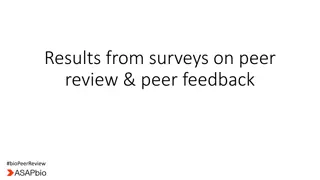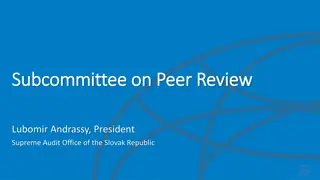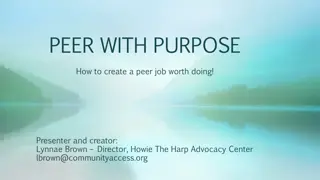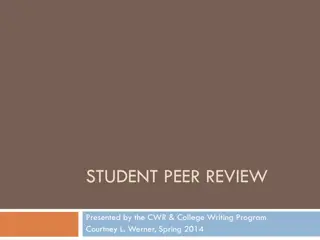Peer Instruction in C++ Programming
Peer instruction materials by Cynthia Bailey Lee for CS2 in C++. Learn about the course structure, participation, and how to engage in class discussions effectively. Understand the role of the instructor as a guide and facilitator in the learning process. Discover the interactive learning approach that involves group discussions and unanimous decision-making. Get ready to enhance your C++ programming skills through collaborative learning methods.
Download Presentation

Please find below an Image/Link to download the presentation.
The content on the website is provided AS IS for your information and personal use only. It may not be sold, licensed, or shared on other websites without obtaining consent from the author.If you encounter any issues during the download, it is possible that the publisher has removed the file from their server.
You are allowed to download the files provided on this website for personal or commercial use, subject to the condition that they are used lawfully. All files are the property of their respective owners.
The content on the website is provided AS IS for your information and personal use only. It may not be sold, licensed, or shared on other websites without obtaining consent from the author.
E N D
Presentation Transcript
Creative Commons License CS2 in C++ Peer Instruction Materials by Cynthia Bailey Lee is licensed under a Creative Commons Attribution-NonCommercial- ShareAlike 4.0 International License. Permissions beyond the scope of this license may be available at http://peerinstruction4cs.org. CS 106X Programming Abstractions in C++ Cynthia Bailey Lee
2 Today s Topics Course structure and procedures: Your Grade My role Your role What is this class? What do we mean by abstractions ? Next lecture: Introduce the C++ language from the Java programmer s perspective (But it s ok if you are not a Java programmer) 1. 2.
3 The Basics: Your Grade 4% Class participation 4% Section participation 20% Midterm 30% Final 42% Programming assignments (6% each)
4 What do I do in class? Think of me as your tutor That means that what I do is: Be your guide in inducing you to explore concepts Create situations and pose puzzles that set the scene for yourexploration Answer your questions Notspend lecture reading the textbook to you with slightly different words
5 What do you do in class? (Before class, you prepare yourself by reading the textbook/handouts) I ask a question 1.
6 What do you do in class? (Before class, you prepare yourself by reading the textbook/handouts) I ask a question You first answer it by yourself 1. 2.
7 What do you do in class? (Before class, you prepare yourself by reading the textbook/handouts) I ask a question You first answer it by yourself Then discuss in assigned groups of 3-4 students Like a jury, you must come to a unanimous decision Answer the question a second time 1. 2. 3.
8 What do you do in class? (Before class, you prepare yourself by reading the textbook/handouts) I ask a question You first answer it by yourself Then discuss in assigned groups of 3-4 students Like a jury, you must come to a unanimous decision Answer the question a second time I will ask groups to share their insights, and I will provide additional clarification as needed 1. 2. 3. 4.
9 FAQ: But Professor Lee, wouldn t it be more efficient if you just taught us the right answer to begin with? Have you ever heard of an aerobics class where the instructor did all the exercises at the front of class, while the class just watched attentively? Me neither. To learn, you must do the work with your own muscle (your brain).
10 What do you do in this course? Prepare for maximum in-class learning Reading, reading quizzes In class: engage with your neighbors and the class, engage with the ideas Turn them upside down and sideways, think about what common errors or misconceptions might be Seek help In class, section, Piazza forum, TA office hours, instructor office hours, LaIR
11 Whoshould you bein this course? Be a professional Take the time to truly learn and transform yourself into a professional, not cram or work for points Be warm and generous Be invested in the progress and well-being of your classmates Be earnest Let your participation to be characterized by risk-taking and a headlong dive into the activity. Free yourself of the need to withhold part of yourself or remain aloof. Be honest Decide today to follow a path of uncompromised integrity in your work in this course and throughout your Stanford career. Envision yourself in the future with the confidence that can only be purchased with a long record of scrupulous decision-making.
About the textbook Required textbook: Programming Abstractions in C++ by Eric Roberts Prof. Roberts is a faculty member here at Stanford Note: do not buy C version
What is this class about? What do we mean by abstractions ?
http://www.publicdomainpictures.net/pictures/10000/velka/1-1265899974oKJ9.jpghttp://www.publicdomainpictures.net/pictures/10000/velka/1-1265899974oKJ9.jpg
http://www.publicdomainpictures.net/pictures/10000/velka/1-1265899974oKJ9.jpghttp://www.publicdomainpictures.net/pictures/10000/velka/1-1265899974oKJ9.jpg
Sentence Subject Verb Phrase Object Noun Adverb Verb Noun Possessive CS106X totally rocks my socks
CS106X totally rocks my socks
Building a vocabulary of abstractions makes it possible to represent and solve a huge variety of problems using known tools.
19 A first C++ program (ERROR) firstprogram.cpp #include <iostream> #include "console.h" using namespace std; int main(){ cout << "|-5| = " << absoluteValue(-5) << endl; return 0; } int absoluteValue(int n) { if (n<0){ return -n; } return n; }
20 A first C++ program (FIXED 1) #include <iostream> #include "console.h" using namespace std; firstprogram.cpp int absoluteValue(int n) { if (n<0){ return -n; } return n; } int main(){ cout << "|-5| = " << absoluteValue(-5) << endl; return 0; }
21 A first C++ program (FIXED 2) #include <iostream> #include "console.h" using namespace std; firstprogram.cpp int absoluteValue(int n); int main(){ cout << "|-5| = " << absoluteValue(-5) << endl; return 0; } int absoluteValue(int n) { if (n<0){ return -n; } return n; }
Question: Why does C++ have the function prototype syntax? In other words, why not just have a rule that you must set up the ordering so you define your functions before using them, as in the FIXED 1 example? A. C++ could have done that, but such a rule would be cumbersome. B. C++ could have done that, but good programming practice dictates top-down approach that logically puts main() first and helper functions it calls to follow. C. C++ couldn t have done that sometimes there is no way to order the functions so that all functions are defined before being used. D. All/none/more than one of the above
Question: Why does C++ have the function prototype syntax? The rationales behind choices (A) and (B) (previous slide) are correct May or may not have been enough to compel the language designers to introduce the function prototype feature (C) is true there are cases where you simply cannot rearrange the ordering of functions to avoid all cases of use before definition e.g., mutual recursion
Mutual recursion #include<iostream> #include "simpio.h" #include "console.h" using namespace std; void go(int n) { if (n == 0) return; cout << "Go!" << endl; stanford(n-1); } void go(int n); void stanford(int n); void stanford(int n) { cout << "Stanford!" << endl; go(n); } int main(){ int n = getInteger("Enter a number of times to repeat: "); go(n); return 0; }
